Volcano Live
volcanolive.com
Mauno Loa Volcano | John Seach

Big Island, Hawaii
19.47 N, 155.60 W,
summit elevation 4170 m
shield volcano
Mauna Loa volcano is one of the tallest mountains in the world. When measured from its base on the sea floor, it rises more than 17,000 m (56,000 feet). Mauna Loa volcano ended its longest historical period of inactivity with the eruption beginning on 27 November 2022. Mauna Loa volcano is spreading because its size is large compared to the thin basal layer.
Mauna Loa volcano photos by John Seach
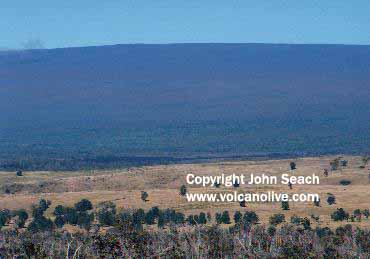
Mauna Loa Volcano - John Seach
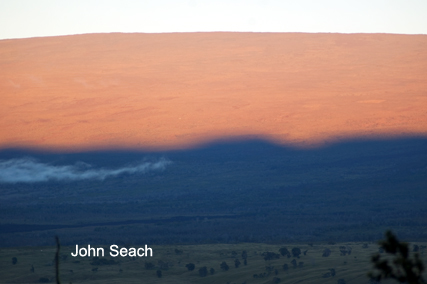
Mauna Loa volcano
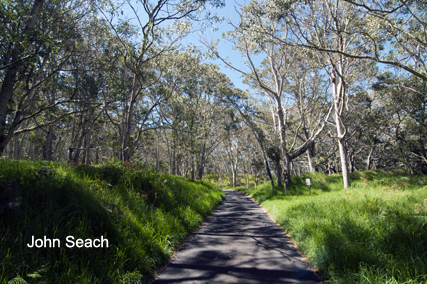
Mauna Loa road, Hawaii
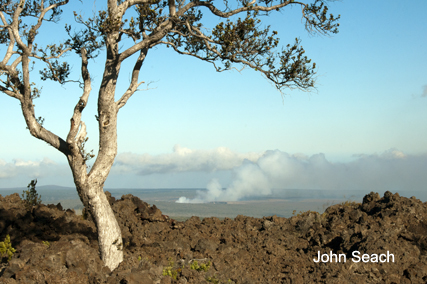
Kilauea eruption from Mauna Loa volcano
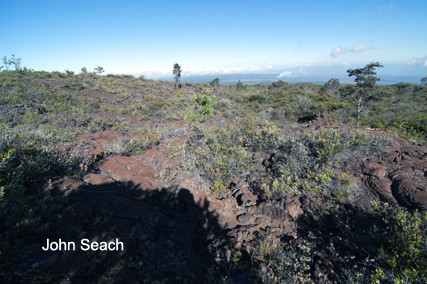
Mauna Loa volcano looking towards Kilauea summit eruption.
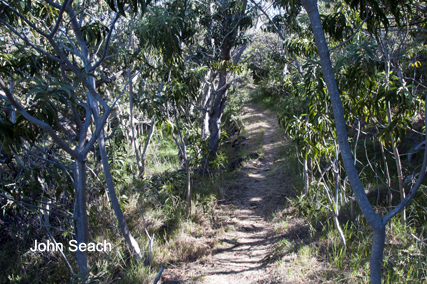
Mauna Loa trail at 7000 ft elevation
Ninole Hills
These hills are located inland from Punalu`u, on the southern side of Mauna Loa volcano. The features are the oldest exposed portions of Mauna Loa volcano, and have been placed in their location by landslides on Mauna Loa. Lava from the hills erupted about 100,000 years ago.
2022 Eruption
A summit eruptiuon began at Mauna Loa Volcano at 11:30 pm local time on 27 November 2022
2022 Seismic activity
On 5th October 2022 the summit of Mauna Loa was closed to climbers due to elevated seismic activity.
2009-2010 Inflation stopped
Inflation of Mauna Loa volcano stopped in late October 2009. On 30th March 2010 Hawaii Volcano Observatory decreased the alert level at Mauna Loa volcano from yellow to green (the lowest level).
1984 Eruption
Early on the morning of 25th March 1984, a magnitude 4 earthquake accompanied an eruption of Mauna Loa volcano. Lava fountains were visible in Mokuaweoweo caldera. This was followed by fissures opening on upper NE Rift Zone. By 29th March, lava flows reach within 6.5 km of Hilo. The eruption finished on 15th April 1984.
1975 Eruption
Mauna Loa volcano began erupting on 5th July 1975. A line of fountains occurred in the summit caldera, and extended about 2 km beyond the caldera margin into the southwest rift zone.
1950 Flank Eruption
A large and spectacular eruption from the southwest rift zone of Mauna Loa began on 1st June 1950. The eruption lasted for 23 days, and produced a large volume of lava. The Honokua lava flow covered the 24 km from vent to the ocean, in less than 3 hours.
During the first few hours of the eruption two rapidly moving flows began.
One flow erupted from a fissure between 3,050 m and 3,200 m altitude. It advanced south-southeastward. By early morning on 2nd June it had extended 16 km but was already stagnating. The other flow poured rapidly westward from the vents between 2,740 and 3,050 meters altitude, and reached the ocean at 01:05 on 2nd June 2, having advanced 24 km in a little more than 2.5 hours. This flow destroyed several houses, a filling station, and the Hookena Post Office at the village of Pahoehoe, where it crossed the highway. It has been named the Honokua flow. By daylight on 2nd June the activity of the Honokua flow had greatly diminished, and by 11:00 movement in it had essentially ceased.
Another lava flow at Mauna Loa originated along rift fissures between altitudes of 2,380 m and 2,680 m late on 1st June or early on 2nd June. It reached the highway at 14:00 on June 2 and entered the ocean at 15:30. This flow, which is known as the Kaapuna flow, became the principal lava flow of the eruption. It continued until 13th June, and attained a volume of about 184 million cubic meters. The Kaapuna flow plunged into the ocean over a sea cliff 15 to 25 meters high, gradually building the shore line forward about 160 meters. Many fish were killed, some of them unidentified deepwater species. The eruption is believed to have ended on 23rd June.
The volume of lava poured out during the 1950 eruption of Mauna Loa and remaining above sea level was approximately 387 million cubic meters. The amount that entered the sea was more difficult to determine, but it is estimated to have exceeded 76 million cubic meters. The total volume of lava erupted was at least 460 million cubic meters. Probably between a third and a half of the total volume was extruded during the first 36 hours of the eruption. The area covered by the flows above sea level was 90.4 square kilometers.
1942 Flank Eruption
A flank eruption occurred at Mauna Loa volcano in April 1942. The eruption occurred only four months after the attacks on pearl Harbour, and during a period of nightly imposed blackouts. Lava began erupting from a fissure at 285 m altitude, 14.5 km northeast of North Bay.
Like most flank eruptions of Manna Loa, the 1942 eruption began with a brief period of eruption in and near the summit caldera. The summit phase of the eruption commenced at approximately 17:05 on 26th April, with the opening of a fissure part way up the cliff along the western side of Mokuaweoweo caldera, across North Bay, and about 4 kilometers down the northeast rift zone. A voluminous amount of fluid, gas rich pahoehoe lava cascaded down the western wall of the caldera.
The flank eruption at Mauna Loa began at approximately 04:40 on the morning of 28th April. Lava broke out along a fissure in the rift zone about 2.4 kilometers northeast of Puu Ulaula at 2800 m altitude. During the day the erupting fissure gradually lengthened downslope, until at 15:00 its length was about a mile. At 20:00 on 28th April the fountains reached a height of about 160 meters.
A lava river 16 meters wide erupted at the eastern end of the cone chain and flowed east-northeast at a rate estimated to reach 25 to 30 kilometers per hour. On 1st May the front of the flow was advancing toward Hilo at a rate of 100 to 150 meters per hour, with a front about half a mile wide. The lava flow stopped at an altitude of 840 meters about 18 kilometers from Hilo. During the threat stage to Hilo, the US Airforce dropped bombs on the lava flow to try and divert its course.
1940 Summit Eruption
After a repose period of 4 years and 3 months, Mauna Loa resumed activity on the evening of 7th April 1940. The eruption consisted of a summit eruption followed by a flank eruption. The eruption began with a continuous line of lava fountains from a series of fissures 5 km long, extending from the centre of Mokuaweowo caldera, to a point over the SW caldera rim.
The first glow from the molten lava was observed by residents of the Kona area, on the western slope of Mauna Loa, at about 23:30. By 00:30 on 8th April a brilliant orange glow illuminated the plume rising from the summit of the volcano. From the vents on the caldera floor very fluid pahoehoe spread over two-thirds of the area of the caldera and all of North Bay. Earthquakes accompanying the 1940 eruption were remarkably few in number.
1907 Eruption
Mauna Loa volcano erupted on the southwest rift on 9th January 1907. The lava flow lasted 15 days and activity at the source continued for a while longer. A fast moving lava flow (Manuka flow) crossed the road on the night of 14th January. The eruption decreased suddenly at the same time an eruption began at the summit of Kilauea volcano.
1903 Eruption
A summit eruption began at Mauna Loa volcano on 1st September 1903. It was observed from the summit of Haleakala on Maui. Eruptions finished by 8th December.
1899 Eruption
A flank eruption of Mauna Loa volcano began on 1st July 1899. Guests at Volcano House were woken by a loud explosion at 2am. Two lava flows were formed, one towards Hilo and the other towards Kau. The eruption site was near the crest of a ridge and small changes in eruption sent lava in different directions.
1896 Eruption
A 16 day summit eruption began at Mauna Loa volcano on 21st April 1896.
1892 Eruption
A three day eruption of Mauna Loa volcano began on 30th November 1892. The eruption occurred at the summit caldera and was not preceded by felt earthquakes.
1887 Eruption
An eruption of Mauna Loa volcano began on 16th January 1887. The eruption was accompanied by strong earthquakes, and began from a small pit crater south of the summit caldera. Lava reached the sea at Puuhue on 19th January after descending from a elevation of 6500 ft. On 23-24 January earthquakes damaged houses in Hilo.
1880-81 Eruption
One of the most historically voluminous eruptions of lava began at Mauna Loa on 5th November 1880. The great eruption lasted 9 months and produced three main lava flows. The eruption was not accompanied by earthquakes or ash emission. The first eruption occurred west of Red Hill at the pit crater Puka Uahi. A second lava flow diverted around Red Hill and flowed towards Kau. A third lava flow moved towards Hilo and flowed between 1852 and 1855 eruptions. This flow stopped only a quarter of a mile from Hilo.
1880 Eruption
On 1st May 1880, a summit eruption began at Mauna Loa volcano. The eruption began with sounds like thunder. The eruption was observed from Hilo, and was described as intense.
1879 Eruption
A summit eruption began at Mauna Loa volcano on 9th March 1879.
1877 Eruption
A summit eruption began at Mauna Loa volcano on 14th February 1877, and was followed by a submarine eruption. Observers said "It looked as if the summit of the mountain was melted, as if the heavens were on fire." A submarine eruption began three miles south of Kealakekua, near the location where Captain Cook was killed, and one mile offshore. The submarine eruption ejected steam, pumice, and scoria into the air. A tsunami reached Kona. The locals reported "red, blue, and green lights dancing in the waters."
1875 Eruption
An eruption began at Mauna Loa volcano summit in January 1875, and lasted several weeks. Another eruption began in August 1875 and lasted for a week.
1873-74 Eruption
An eruption occurred at Mauna Loa occurred in January 1873, and continued for 2-3 weeks. On 20th April Mauna Loa volcano erupted again after 3 months of inactivity. The eruption continued into 1874. Lava fountains were recorded to a height of 200 ft above the summit. Geologist William Green climbed to the summit of Mauna Loa on 6th June 1873 to view the eruption.
1872-73 Eruption
An 18 month long eruption of Mauna Loa volcano began on 18th August 1872. The eruption was confined to the summit caldera.
1871 Eruption
An eruption of Mauna Loa volcano in 1971 was described as "from week to week and month to month it burns in solitude, and shines like a beacon light upon the dark mountain".
1868 Eruption
In 1968 Mauna Loa and Kilauea volcanoes erupted. Lava flows from both reached the sea. The eruption of Mauna Loa volcano created an earthquake swarm with a maximum magnitude 8, which was is the largest historical earthquake in Hawaii. The earthquake caused a tsunami which hit from Hilo to South Cape. The eruption began at the summit followed by the southwest rift. On 7th April a lava erupted from a fissure at 5,600 ft altitude. The lava flow lasted 4 days and destroyed 37 houses.
1865-66 Eruption
A four month long summit eruption of Mauna Loa volcano began on 30th December 1865.
1859 Eruption
On 23rd January 1859 a 10 month eruption began at Mauna Loa volcano. Lava flows destroyed the village of Wainanalii, 12 miles south of Kawaihae on 31 January 1859. The eruption finished in late November after 300 days.
1855-56 Eruption
A 16 month eruption of Mauna Loa began on 11th August 1855. Lava flowed over a distance of 60 miles.
1852 Eruption
The 1851 eruption of Mauna Loa was followed 6 months later by another on 17th February 1852. Lava flowed into forest near Hilo.
1851 Eruption
On 8th August 1851 an eruption began at Mauna Loa volcano. Observers from Hilo saw a white pillar of smoke by day and a brilliant fiery pillar by night.
1935 Eruption
During the eruption of 1935 lava flowed into an old pit crater at 3390 m altitude, disappeared, and then reappeared more than 6.5 km downslope.
1849 Eruption
a brilliant light was visible over Mauna Loa volcano for two or three weeks in May 1849. This was due to summit lava fountaining.
1843 Eruption
An eruption of Mauna Loa volcano began on 9th January 1843. The flank eruption lasted 90 days. Kilauea volcano was erupting at the same time, and was not affected by this eruption. It was concluded that the two volcanoes do not share a common magma reservoir.
1832 Eruption
On 20th June 1832 an eruption began at Mauna Loa and lasted for 4 weeks. Lava erupted from both summit and flanks.
1803 Eruption
On 21st January 1803 an eruption was observed by John Turnbull on a round the world voyage.
1780 Eruption
An eruption occurred soon after captain Cook's death in 1779.
Further reading
Decker, R.W., Klein, F.W., Okamura, A.T. and Okubo, P.G., 1995. Forecasting eruptions of Mauna Loa Volcano, Hawaii. Washington DC American Geophysical Union Geophysical Monograph Series, 92, pp.337-348.
Lockwood, J.P. and Lipman, P.W., 1987. Holocene eruptive history of Mauna Loa volcano. US Geol. Surv. Prof. Pap, 1350(1), pp.509-535.
Lockwood, J., Banks, N., English, T., Greenland, P., Jackson, D., Johnson, D., Koyanagi, B., McGee, K., Okamura, A. and Rhodes, M., 1985. The 1984 eruption of Mauna Loa Volcano, Hawaii. Eos, Transactions American Geophysical Union, 66(16), pp.169-171.
Mauno Loa Volcano Eruptions
2022, 1984, 1975, 1950, 1949, 1942, 1940, 1935-36, 1933, 1926, 1919, 1916, 1914-15, 1907, 1903, 1899, 1896, 1892, 1887, 1880-81, 1880, 1879, 1877, 1876, 1875, 1873-74, 1873, 1872-73, 1871, 1868, 1865-66, 1859, 1855-56, 1852, 1851, 1849, 1843, 1832, 1803, 1780?